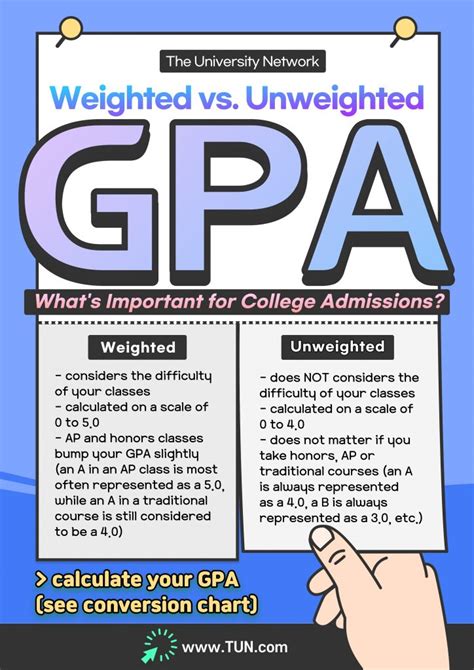Calculating an unweighted GPA (Grade Point Average) is a straightforward process that requires you to follow these steps:

Step 1: Convert Letter Grades to Numerical Values
Each letter grade corresponds to a specific numerical value:
| Letter Grade | Numerical Value |
|---|---|
| A | 4.0 |
| A- | 3.7 |
| B+ | 3.3 |
| B | 3.0 |
| B- | 2.7 |
| C+ | 2.3 |
| C | 2.0 |
| C- | 1.7 |
| D+ | 1.3 |
| D | 1.0 |
| F | 0.0 |
Step 2: Add Up the Numerical Values
Once you have converted all the grades to numerical values, add them all up.
Step 3: Divide by the Number of Classes
Finally, divide the total numerical value by the number of classes you took to get your unweighted GPA.
Example:
Let’s say you took 5 classes and received the following grades:
| Class | Letter Grade | Numerical Value |
|---|---|---|
| English | A | 4.0 |
| Math | B | 3.0 |
| Science | B+ | 3.3 |
| History | C | 2.0 |
| Language | A- | 3.7 |
Unweighted GPA Calculation:
-
Convert letter grades to numerical values:
- English: 4.0
- Math: 3.0
- Science: 3.3
- History: 2.0
- Language: 3.7
-
Add up numerical values:
4.0 + 3.0 + 3.3 + 2.0 + 3.7 = 16.0 -
Divide by the number of classes:
16.0 / 5 = 3.2
Therefore, your unweighted GPA for these 5 classes is 3.2.
An unweighted GPA provides a simple and transparent measure of a student’s academic performance. It is often used by schools and colleges to:
- Evaluate students’ academic preparedness
- Determine eligibility for scholarships and honors programs
- Make admission decisions
When calculating an unweighted GPA, it is important to consider the following:
- Course Difficulty: All classes are treated equally, regardless of their difficulty level.
- Class Load: The number of classes taken in a term/semester can affect the GPA. Taking more challenging classes or more classes can impact the calculation.
Avoid the following mistakes when calculating an unweighted GPA:
- Error in converting letter grades to numerical values
- Miscounting the number of classes
- Including weighted grades (e.g., honors or AP courses)
If you are looking to improve your unweighted GPA, consider the following tips:
- Prioritize your studies
- Seek help from teachers and tutors
- Focus on completing assignments promptly
- Review material regularly
- Stay organized and track your progress
Benefits of a High Unweighted GPA
Having a high unweighted GPA can open doors to opportunities such as:
- Increased scholarship eligibility
- Enrolling in competitive academic programs
- Enhancing future job prospects
Challenges of Maintaining a High Unweighted GPA
Maintaining a high unweighted GPA requires:
- Consistent effort throughout the academic term/semester
- Time management skills
- Balancing academic and extracurricular activities
Calculating an unweighted GPA is a simple and straightforward process. By understanding the steps involved and avoiding common mistakes, you can accurately determine your academic standing. Remember that a GPA is not just a number but a reflection of your efforts and commitment to learning.
